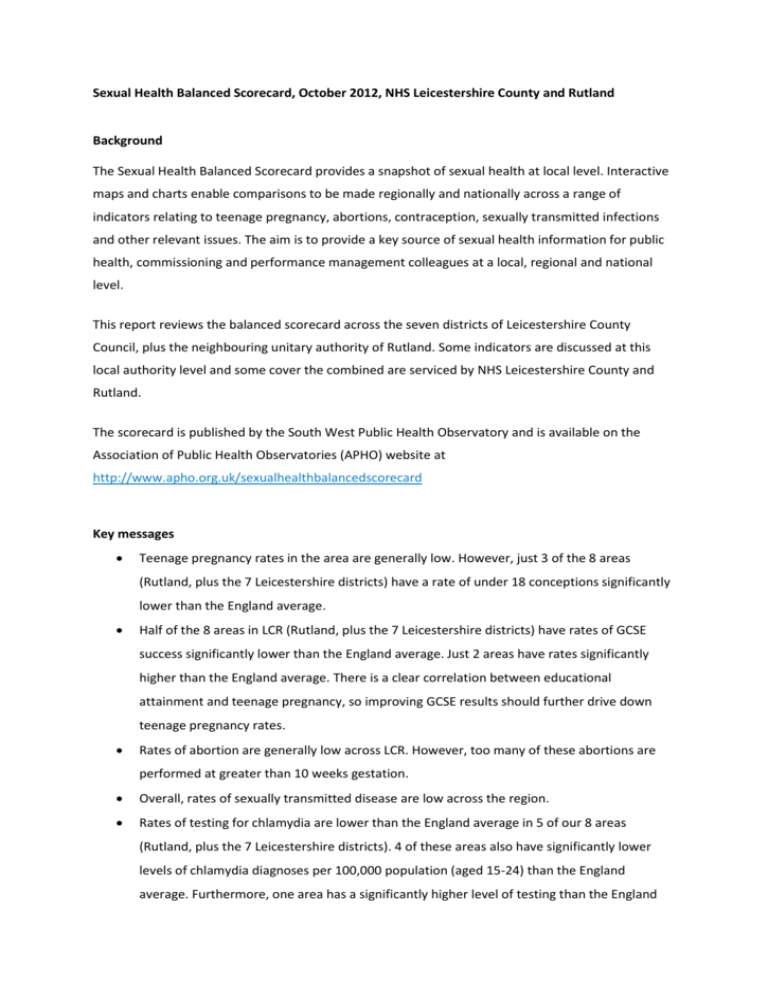
Sexual Health Balanced Scorecard, October 2012, NHS Leicestershire County and Rutland
Background
The Sexual Health Balanced Scorecard provides a snapshot of sexual health at local level. Interactive
maps and charts enable comparisons to be made regionally and nationally across a range of
indicators relating to teenage pregnancy, abortions, contraception, sexually transmitted infections
and other relevant issues. The aim is to provide a key source of sexual health information for public
health, commissioning and performance management colleagues at a local, regional and national
level.
This report reviews the balanced scorecard across the seven districts of Leicestershire County
Council, plus the neighbouring unitary authority of Rutland. Some indicators are discussed at this
local authority level and some cover the combined are serviced by NHS Leicestershire County and
Rutland.
The scorecard is published by the South West Public Health Observatory and is available on the
Association of Public Health Observatories (APHO) website at
http://www.apho.org.uk/sexualhealthbalancedscorecard
Key messages
Teenage pregnancy rates in the area are generally low. However, just 3 of the 8 areas
(Rutland, plus the 7 Leicestershire districts) have a rate of under 18 conceptions significantly
lower than the England average.
Half of the 8 areas in LCR (Rutland, plus the 7 Leicestershire districts) have rates of GCSE
success significantly lower than the England average. Just 2 areas have rates significantly
higher than the England average. There is a clear correlation between educational
attainment and teenage pregnancy, so improving GCSE results should further drive down
teenage pregnancy rates.
Rates of abortion are generally low across LCR. However, too many of these abortions are
performed at greater than 10 weeks gestation.
Overall, rates of sexually transmitted disease are low across the region.
Rates of testing for chlamydia are lower than the England average in 5 of our 8 areas
(Rutland, plus the 7 Leicestershire districts). 4 of these areas also have significantly lower
levels of chlamydia diagnoses per 100,000 population (aged 15-24) than the England
average. Furthermore, one area has a significantly higher level of testing than the England
average, and a significantly higher rate of diagnosis. Improving testing rates in the areas that
are under-performing should therefore lead to increased rates of diagnosis in those areas.
The Indicators
The indicators are divided into 8 sections
teenage conceptions
abortions;
contraception
sexually transmitted infections and HIV
awareness, attitudes and risk behaviour
schools, colleges and Connexions service
sexual assaults
other related factors.
Each indicator is designated as either a key indicator or a supporting indicator. Different indicators
are available at PCT level and at lower-tier local authority level. However, there is some overlap
between PCT and local authority indicators. A RAG chart showing the indicators and the levels of
significance compared to the England average is in appendix one.
Teenage conceptions
Most teenage pregnancies are unplanned and around half end in an abortion. As well as it being an
avoidable experience for the young woman, abortions represent an avoidable cost to the NHS. While
for some young women having a child when young can represent a positive turning point in their
lives, for many more teenagers bringing up a child is incredibly difficult and often results in poor
outcomes for both the teenage parent and the child, in terms of the baby’s health, the mother’s
emotional health and well-being and the likelihood of both the parent and child living in long-term
povertyi.
For pooled years 2008-2010 the under 18 conception rate (27.6 per 1000 females aged 1517) in LCR was significantly lower than the England average.
For 2010 the under 18 conception rate (24.7 per 1000 females aged 15-17) in LCR was also
significantly lower than the England average. It was also significantly low in Blaby, Rutland
and Harborough. The other LCR districts had a similar rate to the England average.
For under 16 conceptions in 2010 (4.5 per 1000 females aged 15-17) LCR had a significantly
lower rate than the England average. The under 16 conception rate was also significantly
low in Charnwood, Harborough and Rutland. The other LCR districts had a similar rate to the
England average.
Between 1998 and 2010 the teenage pregnancy rate in LCR dropped by 32.1%, this was a
similar drop to the England average (24.0%). The rate in Rutland and all seven Leicestershire
districts dropped by a similar percentage to the England average. However, this is based on
individual years and there is considerable variation from year to year. Using pooled years
would give a more robust picture of the situation. More information is available in the Joint
Strategic Needs Assessment.
Abortions
The level of abortions is an indicator of the degree of failure to use contraception or to use it
effectively, or failure of the contraception itself. It suggests the need for improved sex and
relationships education and/or access to effective contraception and advice. Teenagers are a
particularly vulnerable groupi.
In 2011, LCR performed significantly fewer abortions (12.8 per 1000 women) than the
England average (17.6 per 1000 women).
However, significantly fewer of these (68.5%) were performed at 10 weeks or less gestation,
than the England average of 77.9%.
In 2011, LCR performed significantly fewer abortions on women under 18 (11.7 per 1000
women aged 15-17) compared to the England average (15.1 per 1000 women aged 15-17).
In 2011, in LCR 70.9% of these abortions on women less than 18 were performed at 10
weeks or less gestation. This is similar to the England average of 70.8%.
For the pooled years of 2009-11, LCR performed significantly fewer abortions on women
under 16 (2.9 per 1000 women aged 13-15) than the England average (3.8 per 1000 women
aged 13-15).
For the pooled years of 2009-11, the rate of abortions on women less than 16 performed at
10 weeks or less gestation, was 61.3% - similar to the England average of 66.7%.
In 2011, LCR had a significantly lower rate of repeat abortions on women under 25 (20.1% of
total abortions on women under 25) than the England average of 26.4%. For women under
19, the LCR rate was 9.6%, similar to the England average of 10.9%.
Contraception
A strategic priority is to ensure access to the full range of contraception is available to all. LARC (long
acting reversible contraception) methods are highly effective and cost effective. An increase in the
provision of LARC is a proxy measure for wider access to the range of contraceptive methods and
should also lead to a reduction in rates of unintended pregnancyi.
LCR has a significantly higher rate of GP prescribed LARC (62.2 per 1000 women) than the
England average of 52.4 per 1000 women.
Sexually transmitted infections and HIV
Sexually transmitted infections continue to be an important public health problem in England. The
data shows that a significant burden of STIs exists within the populationi.
Between January and November 2011, 99.8% of GUM clients in LCR were offered an
appointment within 2 working days. This is equal to the England average. The target is 100%.
92.5% of GUM clinic clients across LCR are seen within 2 working days – this is significantly
better than the England average of 88.4%.
For diagnoses of acute sexually transmitted diseases, Rutland and the seven districts of
Leicestershire have rates significantly lower than the England average of 792.1 per 100,000
population (Blaby 730.7, Charnwood 712.2, Harborough 417.8, Hinckley and Bosworth
547.2, Melton 331.5, North West Leicestershire 458.2, Oadby and Wigston 546.6, Rutland
435.7).
Chlamydia is the most common bacterial sexually transmitted infection in England. If these
infections are undiagnosed and untreated, complications such as pelvic inflammatory disease,
ectopic pregnancy and tubal factor infertility in males and females can develop. Undiagnosed
infections also increase the chances of infecting othersi. In the context of chlamydia, higher rates of
diagnoses are considered to be better as more of the underlying problem is being discovered and
treated.
In 2011 Blaby had a significantly higher rate (2,626.0 per 100,000 population aged 15-24)
than the England average (2,124.6) for chlamydia diagnosis in all settings for patients aged
15-24. Hinckley and Bosworth (1,989.8), and Melton (1,777.6) had rates similar to the
England average, while Rutland (782.6) and the remaining Leicestershire districts
(Charnwood 1,585.1, Harborough 1,306.5, North West Leicestershire 1,530.4, Oadby and
Wigston 1,092.7) had rates significantly lower than the England average.
In 2010-11, LCR had a significantly lower rate of chlamydia testing on patients aged 15-24
outside GUM clinics (18.6% of target age group) than the England average (25.2%).
This LCR overview hides some local good news - in 2011-12, Blaby (22.3%) and Melton
(21.7%) had significantly higher rates of testing this age group than the England average
(20.5%). North West Leicestershire (21.0%) had a rate similar to the England average, while
Charnwood (17.0%), Harborough (16.9%), Hinckley and Bosworth (15.3%), Oadby and
Wigston (12.7%), and Rutland (10.0%) had significantly lower rates.
Pelvic Inflammatory Disease (PID) is a clinical syndrome referring to infection and inflammation of
the upper female genital tract. Many people with PID may not be aware that they have it; however it
can lead to serious complications such as ectopic pregnancy, infertility and chronic pelvic pain.
Chlamydial infection is a common cause of PID and this indicator could help inform targeting of
chlamydia testingi.
In 2009/10 LCR had a similar rate to the England average for pelvic inflammatory disease in
women under 30.
Figures are available for 2010/11 at local authority level but the definition was expanded to
include all women under 45. For this indicator, Rutland and all 7 Leicestershire districts were
similar to the England average.
Gonorrhoea is used as a marker for rates of unsafe sexual activity. This is because gonorrhoea is
easily treated and cured, the majority of cases are diagnosed in GUM and consequently the number
of cases may be a measure of access to STI treatment. Infections with gonorrhoea are also more
likely than chlamydia to result in symptomsi.
LCR had a significantly lower rate of diagnoses of gonorrhoea in GUM clinics than the
England average in 2010.
In 2011, Blaby, Charnwood, Harborough and North West Leicestershire had significantly
lower rates than the England average, while Rutland and the other Leicestershire districts
had rates similar to the England average.
Syphilis is an important public health issue in men who have sex with men (MSM) and reproductive
age women, among whom incidence has increased over the past decade. Syphilis is also primarily
diagnosed in GUM clinics. Syphilis is included as an indicator because syphilis trends are different to
those of gonorrhoea. Although syphilis is still relatively rare, the number of new infections has
increased, mostly among MSMi.
In 2010, LCR had a significantly lower rate of syphilis diagnoses in GUM clinics than the
England average.
However, for 2011 figures, Rutland and all 7 Leicestershire districts had rates similar to the
England average. This may indicate a rise from 2010 to 2011.
Early diagnosis and treatment of HIV infection are critical to reduce the likelihood of infecting others
and of developing serious and life threatening medical conditions. The majority of sexual health
screens and HIV tests take place in GUM clinics. Any person presenting to a GUM clinic should be
offered an HIV test regardless of symptoms and risk factorsi.
The significance of the prevalence of diagnosed HIV in the 15-59 age group has not been
calculated. However, the England average in 2011 was 1.9 per 1000 population. The rate in
Blaby was 0.7, Charnwood 0.7, Harborough 0.5, Hinckley and Bosworth 0.6, Melton 0.3,
North West Leicestershire 0.6, Oadby and Wigston 0.7, Rutland 0.4.
In 2010, LCR had a rate significantly higher (86.3%) than the England average (78.1%) for the
uptake of HIV tests in GUM clinics.
In 2011, Blaby, Charnwood, Harborough, Hinckley and Bosworth, North West Leicestershire
and Oadby and Wigston had rates of testing significantly higher than the England average
(80.3%). Melton and Rutland had rates similar to the England average.
Rates of late HIV diagnosis in LCR in 2009 were similar (60%) to the England average (51.3%).
For the pooled years 2008-10, Blaby, Charnwood, Hinckley and Bosworth, North West
Leicestershire and Oadby and Wigston all had rates similar to the England average( 52.3%)
for late HIV diagnoses. Numbers for Harborough, Melton and Rutland were so low that the
figures have been supressed to protect patient identities (this does not necessarily mean
that the rate was low).
Awareness, attitudes and behaviour
The national HPV vaccination programme for girls aged 12-13 began in September 2008 and over
time this has the potential to radically bring down rates of cervical cancer. While it might be argued
that the primary outcome of vaccination is not directly related to the sexual health strategy, uptake
of the vaccine is likely to be affected by social attitudes to sexual activity among teenagers and
specifically the attitudes of parentsi.
LCR has a significantly higher rate of age 12-13 HPV uptake of vaccine, first dose (93.6%),
than the England average (88.9%).
The review ‘Progress and Priorities – Working Together for High Quality Sexual Health – Review of
the National Strategy for Sexual Health and HIV’, (July, 2008) has expressed concerns that schools
give insufficient emphasis to the teaching of HIV, sexual health and the more sensitive aspects of
SRE. Furthermore, young people continue to report poor-quality SRE, which is not meeting their
needsi.
Both Leicestershire and Rutland have a similar rate to the England average for 12-15 year
olds who say that sex and relationships education is helpful.
The paper ‘Sex, Drugs, Alcohol and Young People – a review of the impact drugs and alcohol have on
young people’s sexual behaviour’ published June 2007 by the Independent Advisory Group on Sexual
Health and HIV highlighted key findings such as the strong correlation between STIs, sexual
behaviour and drug use; and the links between substance use and risky sexual behaviour being
considerablei
Both Leicestershire and Rutland have higher rates (11.2% and 10.2% respectively) than the
England average (9.8%) for 10-15 year olds reporting frequent substance misuse. It has not
been possible to calculate significance levels for this indicator.
Schools, colleges and Connexions service
The Teenage Pregnancy Strategy (launched 1999) included the target to increase the proportion of
teenage mothers in education, training or employment to 60% by 2010 to reduce their risk of longterm social exclusion (and disadvantages for their children). Teenage mothers are less likely to finish
their education, less likely to find a good job and more likely to end up as single parentsi.
Leicestershire had a rate significantly higher (41.2%) than the England average of 30% for
the proportion of mothers aged 16-18 in employment, education or training in December
2011. However, this is clearly some way short of the target. The figure for Rutland has been
supressed to protect patient confidentiality, so nothing can be said about the rate in that
area.
Sexual assaults
‘Progress and Priorities – Working Together for High Quality Sexual Health – Review of the National
Strategy for Sexual Health and HIV’ (2008) identified sexual assault as a gap in the original Strategy:
‘people who have experienced sexual assault have multiple ongoing sexual health needs including
addressing pregnancy risk, risks of infection and psychosocial impacts.’i.
For police recorded rape in females, Blaby, Charnwood, Harborough, and Oadby and
Wigston have a rate significantly lower than the England average. Rutland and the remaining
districts of Leicestershire have rates similar to the England average of 52.1 reported assaults
per 100,000 female population.
Older information (2010/11) is available for the PCT as a whole – this shows a rate
significantly lower than the England average of 53.1 reported assaults per 100,000 female
population.
Other related factors
The likelihood of teenage pregnancy is far higher among those with poor educational attainment,
even after adjusting for the effects of deprivationi.
Blaby, Charnwood, Hinckley and Bosworth, and Melton have rates of GCSE achievement of 5
A-C grades including English and Maths, significantly lower than the England average
(58.4%). North West Leicestershire and Rutland have rates similar to the England average.
Only Harborough and Oadby and Wigston have rates significantly better than the England
average.
Older information (2009/10) is available at PCT level – this shows the rate as similar to the
England average of 55.3%.
There is a strong link between social deprivation and sexually transmitted infections, teenage
conceptions and abortionsi.
For average deprivation score, no test of significance is possible. However, Rutland and all 7
Leicestershire districts have scores lower than the median score for England, indicating
levels of deprivation lower than the England average.
The proportion of the population living in areas considered to be in the 20% most deprived
in England is significantly lower in Rutland and all 7 Leicestershire districts than the England
average.
Teenage
conceptions
Abortions
Age under 18
abortions 2011
Under 18
conceptions
leading to
abortion
Age under 16
abortions 2009-11
Total abortions
2011
All NHS funded
abortions <10
weeks
Age under 18
abortions <10
weeks
Age under 16
abortions <10
weeks
Key
Similar
Similar
Similar
Similar
Similar
Similar
Similar
Similar
Similar
Support
Sig
better
Sig
better
Similar
Sig
better
Similar
Similar
Similar
Similar
Sig
better
Support
Sig
better
Sig
better
Similar
Sig
better
Sig
better
Similar
Similar
Similar
Similar
Sig
better
Support
Sig
better
Similar
Similar
Similar
Similar
Similar
Similar
Similar
Supressed
Support
Support
Support
Sig
better
Sig
better
Key
Sig
worse
Key
Similar
Support
Similar
Support
Leicestershire
Rutland
Oadby and
Wigston
North West
Leicestershire
Melton
Hinckley and
Bosworth
Harborough
Charnwood
Blaby
Indicator
Change age under
18 conceptions
Age under 18
conceptions
(2010)
Age under 18
conceptions
(2008-10)
Age under 16
conceptions 2010
LCR
Indicator set
Key or support
Appendix One – RAG chart
Contraceptio
n
Sexually
transmitted
infections
and HIV
Key
Support
Similar
Sig
better
Sig
better
Sig
better
Key
Not
calculated
Key
Sig
better
Support
Sig
better
Support
Sig
better
Support
Key
Sig
better
Sig
better
Sig
better
Sig
better
Sig
better
Sig
better
Sig
better
Sig
better
Key
Sig
worse
(archive)
Sig
better
Sig
worse
Sig
worse
Sig
worse
Sig
better
Similar
Sig
worse
Sig
worse
Support
Similar
(archive)
Sig
higher
Similar
Similar
Similar
Similar
Sig
lower
Sig
lower
Similar
Key
Leicestershire
Rutland
Oadby and
Wigston
North West
Leicestershire
Melton
Hinckley and
Bosworth
Harborough
Charnwood
Blaby
LCR
Indicator
Age under 19
repeat abortions
Age under 25
repeat abortions
GP prescribed
LARC
Cost of GP
prescribed LARC
GUM clinic clients
offered
appointment
within 2 days
GUM clinic clients
seen within 2
days
GUM clinic clients
did not attend
first appointment
GUM clinic clients
seen after 10
working days
Acute sexually
transmitted
infections
diagnoses
Age 15-24 tested
for chlamydia
outside GUM
clinics
Age 15-24 tested
positive for
chlamydia outside
GUM clinics
Key or support
Indicator set
Syphilis diagnoses
in GUM clinics
Uptake of HIV
tests in GUM
clinics
Awareness,
attitudes and
risk
behaviour
Late HIV diagnosis
Prevalence of
diagnosed HIV in
age 15-59
Age 12-13 uptake
HPV vaccine, first
dose
Age 12-15 say sex
and relationships
education helpful
Age 10-15
frequent
substance misuse
Key
Sig
lower
(archive)
Support
Similar
(archive)
Support
Key
Key
Key
Key
Sig
better
(archive)
Sig
better
(archive)
Sig
better
(archive)
Similar
(archive)
Key
Support
Leicestershire
Rutland
Oadby and
Wigston
North West
Leicestershire
Melton
Hinckley and
Bosworth
Harborough
Charnwood
Blaby
LCR
Indicator
Age 15-24
chlamydia
diagnoses in all
settings
Age under 30
pelvic
inflammatory
disease
Age 15-44 pelvic
inflammatory
disease
Gonorrhoea
diagnoses in GUM
clinics
Key or support
Indicator set
Sig
better
Sig
worse
Sig
worse
Similar
Similar
Sig
worse
Sig
worse
Sig
worse
Similar
Similar
Similar
Similar
Similar
Similar
Similar
Similar
Sig
better
Sig
better
Sig
better
Similar
Similar
Sig
better
Similar
Similar
Similar
Similar
Similar
Similar
Similar
Similar
Similar
Similar
Sig
better
Sig
better
Sig
better
Sig
better
Similar
Sig
better
Sig
better
Similar
Similar
Similar
Supressed
Similar
Supressed
Similar
Similar
Supressed
Not calculated
Sig
better
Support
Similar
Similar
Support
Higher
Higher
Schools,
colleges and
Connexions
service
Sexual
assaults
Other related
factors
Police recorded
rape in females
GCSE
achievement 5 AC grades inc
English and Maths
Average
deprivation score
Extent most
deprived
Sig
better
Sig
better
Sig
better
Sig
better
Sig
better
Sig
better
Sig
better
Supressed
Support
Higher
(archive)
Sig
better
(archive)
Sig
better
Sig
better
Sig
better
Similar
Similar
Similar
Sig
better
Similar
Support
Similar
(archive)
Sig
worse
Sig
worse
Sig
better
Sig
worse
Sig
worse
Similar
Sig
better
Similar
Not calculated
Sig
Sig
better
better
Sig
better
Sig
better
Sig
Better
Sig
better
Sig
better
Sig
better
Support
Support
Support
Leicestershire
Rutland
Oadby and
Wigston
North West
Leicestershire
Melton
Hinckley and
Bosworth
Harborough
Charnwood
Blaby
LCR
Indicator
Age 16-18
mothers in EET
where mothers
known to local
authorities
Key or support
Indicator set
Carrie Pailthorpe
Public Health Analyst
NHS Leicestershire County and Rutland
September 2012
i
Sexual Health Balanced Scorecard Metadata







